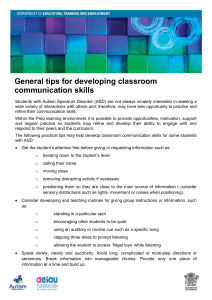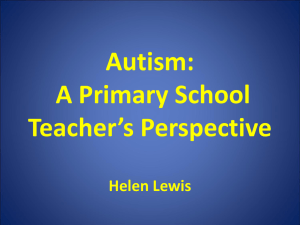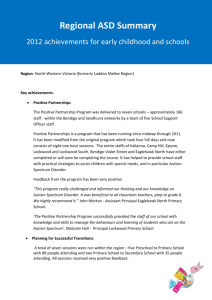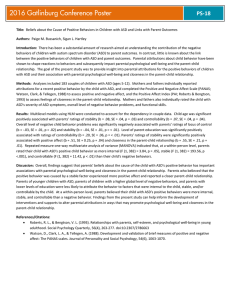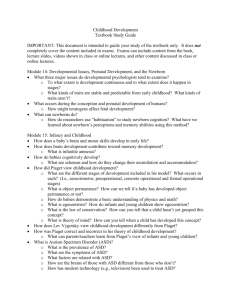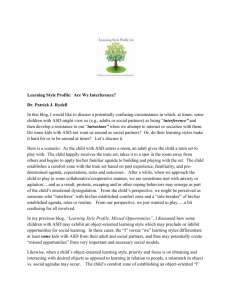Video Modeling Made Easy
advertisement
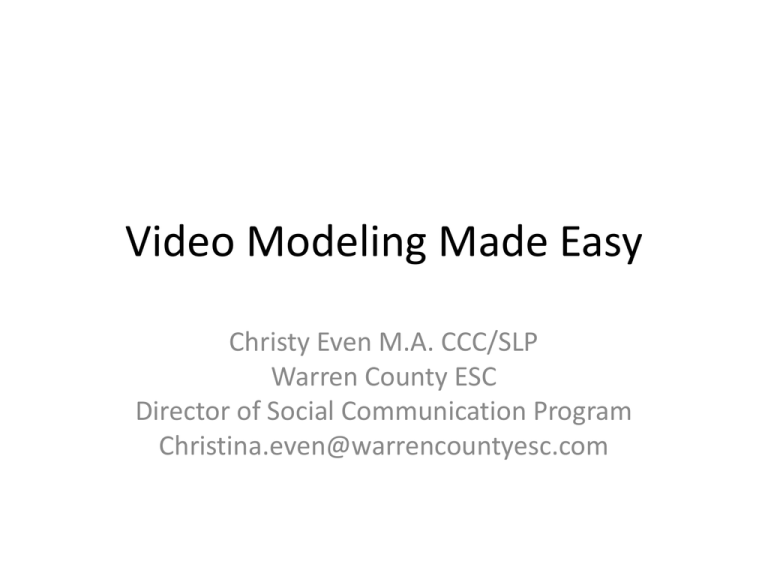
Video Modeling Made Easy Christy Even M.A. CCC/SLP Warren County ESC Director of Social Communication Program Christina.even@warrencountyesc.com Video Modeling • A teaching technique which involves having an individual watch a model perform a target skill on a video tape and then practice the skill that he or she observed. Video Modeling as a Research Based Intervention • Insurance companies will find it harder to turn down coverage for intervention practices rooted in science and guided by sound clinical judgment. • National Professional Development Center on ASD – EBP Grid • IDEIA 2004 – Educational interventions must be based on sound research Evidence Based Practice • Video Modeling has been shown to be an effective means to teach individuals with ASD. • In numerous studies, comprising decades of scientific research, video modeling has been shown to be the most effective method of teaching social skills and target behavior to children with ASD. • Research on children with ASD has shown that video modeling can be very effective in improving the following skills and target behaviors: – – – – – – – – – Social interaction behaviors Academic and functional skills Communication skills Daily living skills Play skills Social initiations Perception of emotion Spontaneous requesting Perspective taking Evidence Based Practice • Video modeling can teach target behaviors very quickly compared to other methods, and the behavior is said to be “generalized,” (i.e., the child is able to exhibit the behavior in real life situations that are similar to the research scenario). • Video modeling has been proven to decrease certain problem behaviors, including aggression, tantrums and other off-task activities. Evidence Based Practice • Recent research has shown that video modeling can be used to teach a variety of skills to students with ASD, either as an intervention by itself or as an intervention component included with prompting and/or reinforcement, Social Stories TM, and self management. Why Does Video Modeling Work? (Corbett & Abdullah, 2005) • Over-selective attention • Restricted field of focus • Preference for visual stimuli and visually cued instruction • Avoidance of face-to-face interactions • Ability to process visual information more readily than verbal information • Presents a variety of different behaviors in realistic contexts. • Serves as a cost effective tool in the treatment of individuals with ASD Different Types of Video Modeling 1. 2. 3. 4. Basic Video Modeling (VM) Video Self-Modeling (VSM) Point-of-View Video Modeling (PVM) Video Prompting Basic Video Modeling (Bellini & Akullian, 2007; Graetz, Mastropieri, & Scruggs, 2006; Sigafoos, O’Reilly, & de la Cruz, 2007) • Recording someone else besides the learner engaging in the targeted skill or behavior. • The learner is asked to watch the video prior to the instruction or application of targeted behavior. • The target skill is modeled by the adult or peer within the activity context. • The learner then imitates the behavior of the model when provided with the opportunity to perform the skills displayed in the video Application Video Self Modeling (Bellini, Akullian, & Hopf, 2007; Hine & Wolery, 2006; Schreibman et al., 2000) • Involves the use of the learner being instructed as the model in the video tape instead of adults or peers. • ONLY the exemplary target behavior of the student is displayed on the video tape • May be paired with written script Application Point-of-View Video Modeling (Hine & Wolery, 2006; Schreibman et al., 2000; Ship;ey-Benamou, Lutzker, & Taubman, 2002) • The process of videotaping elements of the environment or activity context from the visual perspective or vantage point of the student who needs to acquire and/or master the target responses. • The videographer records steps for completing an activity or transitions from one setting to another by actually navigating through the process at the eye level of the student. • When the student reviews the videotape, they see exactly what they are supposed to do from the beginning until the end of the task or routine. • When viewed repeatedly, promotes visual comprehension, increases familiarity with materials and settings, and provides a “picture” of the completed process, apparently reducing task anxiety and inappropriate behavior. Application Video Prompting • Is done by breaking the skill or behavior down into steps (task analysis) • Each step is video recorded separately so that the learner can master the subsequent steps before moving on. Application Quick Tips • Keep it short! Think short commercial length at longest. • Ensure the video tape shows a close-up of the desired action you want imitated. • Following watching the video model, allow the individual with ASD to have sufficient time (at least 2-3 minutes) to demonstrate modeled behavior. • The individual with ASD should watch the same video model sequence again if he/she fails to imitate the behavior(s). • Keep data for every trial and let the individual with ASD have at least 3 successful trials before he/she moves to the next portion of the video model. • Programming for maintenance and generalization of the imitative behavior must take place across settings, stimuli, people, and time. Questions

